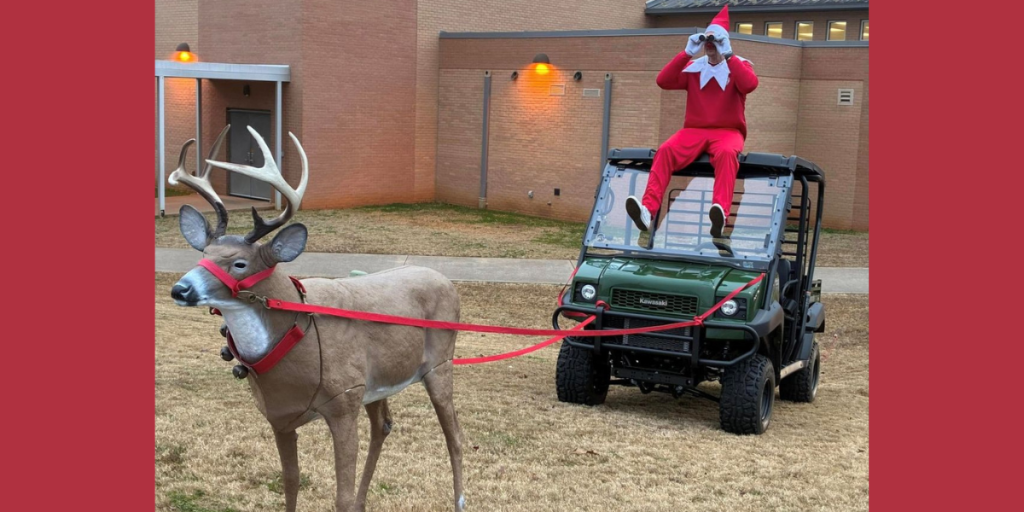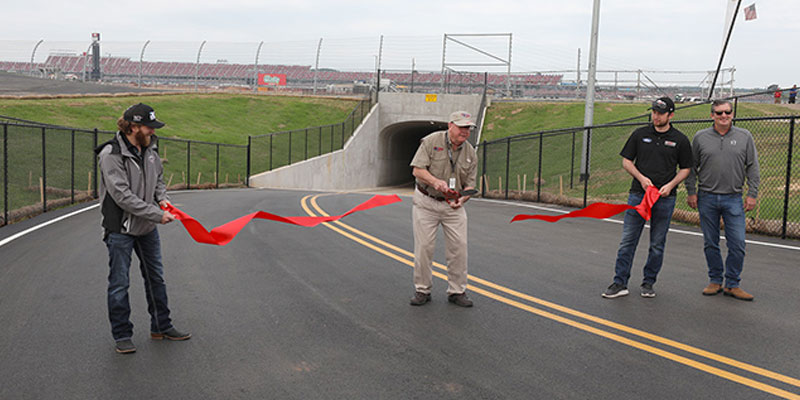To most of the world, Talladega is the big racetrack that opened half a century ago.
The 2.66-mile NASCAR tri-oval 14 miles from downtown Talladega is familiar even to people who care nothing about vehicles racing 200 mph as 175,000 fans scream while nursing their favorite beverages in the bleachers and infield.
Talladega Superspeedway is quickly becoming the “world’s most sophisticated fan experience” as its $50 million redevelopment will be partially complete by the running of the Geico 500 April 28 and fully finished by the big races in October. Billed as the “Transformation,” the rebirth of the famous facility has nothing on its namesake town founded 135 years earlier.
Talladega the city is super in ways millions of followers of Petty, Earnhardt, Gordon and the “Alabama Gang” might never imagine if they haven’t traveled south along Highway 77. The town of about 15,000 residents easily qualifies for the Transformation label, perhaps outdoing the track efforts through reviving the old Courthouse Square, restoring stately mansions and attracting impressive new industries and distinctive businesses.
Talladega’s blend of building new and improving old may be unsurpassed among small towns in Alabama. The manifold instances are too many to mention, but the downtown is a good starting point. The oldest courthouse in continuous use in the state is surrounded by buildings either restored to their glory of the 1800s or under renovations moving in that direction. Even businesses that have failed have fresh facades awaiting new investment.
On one corner is Boswell’s Wings, named after a local doctor who patented airplane components and some claim flew a plane off a barn in 1902, prompting the legend Boswell beat the Wright Brothers in flight by a year. The restaurant was opened last year by local boy-done-good Kevin Smith, who is founder and owner of several companies and lives in Fort Myers, Florida, but frequently visits Talladega. His Artisan’s Alley awaits occupants on another corner downtown. The Purefoy Hotel just behind Courthouse Square is being prepped for a new life. It seems like every direction is undergoing major reconstruction, renovations or set to open doors on new businesses.
Across the street from Boswell’s is the opulent former Talladega Post Office, built in 1913 for $63,395.34 and used for mail until the local Water & Sewer Board moved in 16 years ago. People paying their bill in person today enjoy entering through the six-columned front, walking across the marble floors cut from the Sylacauga quarry, beneath the original brass lighting fixtures and handing their credit card to employees behind old-fashioned barred cashier windows. There are still horse hitching posts in back of the building.
A monument on the courthouse lawn recognizes “The Tremblin’ T,” another unique aspect of the town, dedicated to the USS Talladega that earned seven battle stars in World War II, the Korean War and the Vietnam War. The ship is noted for transporting Marines to Iwo Jima, where they raised the flag for perhaps the most famous WWII photograph. The ship was featured in the classic war movie “Battle Cry.”
A block south of the square stands the 1906 L&N Railroad Station that was restored to house the Chamber of Commerce. Visitors traverse the floors of tile imported from Italy, along 8-inch-tall white marble baseboards, lighted by brass fixtures converted from gas to electricity. Beneath the original red tile roof, guests are often alerted to “April in Talladega,” the 45th annual pilgrimage – April 12-13 this year – showing off antebellum homes, churches and Oak Hill Cemetery. The tour changes each year but frequently features Boxwood (1854) and the Plowman-Heacock Home, generally regarded as the town’s most beautiful tall-columned home.
Not far east of the square is Heritage Hall, built in 1906 by Andrew Carnegie on land given by Louisa Jemison for the local library, which in 1979 moved to a bigger building behind the original. Designed by Frank Lockwood, as are many of Talladega’s most admired homes and structures, the old library with 18-foot-tall ceilings is now the city’s art center. Director Valarie White hosts about 10 exhibits annually, with the state bicentennial celebration of quilts set for April 11-May 31.
Just behind the square next to city hall is the Talladega Walk of Fame and Davey Allison Memorial Park, a full city block with more than 50 bronze plaques describing and dedicated to the greatest NASCAR drivers.
Across the street in front of Piggly Wiggly is the Talladega Battle Monument built in 1968 over the town’s still-bubbling spring. Beneath the four-winged concrete dome are bronze maps and plaques commemorating the players in the 1813 fight led by future President Andrew Jackson, Davy Crockett and U.S. military forces against the local Creek Indians, who were vastly outnumbered and quickly defeated.
Talladega’s Veterans Park – the city’s biggest of nine recreational areas – has a long walking track with bridges that twice traverse a creek. The park has bathrooms, benches, playgrounds, two pavilions with picnic tables, a Little Free Library and WWII tank for visitors to admire. Not far away is the city’s nine-hole public golf course, which is near the Talladega Bowling Center, where children and adults are entertained at night and on weekends. Spring Street Community Center has a 25-meter indoor heated pool and swimming programs for all ages.
Today, Talladega natives often head to Tina’s Home Cookin’ for breakfast, to Café Royale or Custom Pizza for lunch and to the Stampede Steakhouse or Matehuala Mexican for supper. Every day around noon, the parking lot of Fincher’s Delite is packed at the longtime little roadside eatery. Guys go to Michael’s Men’s Wear for clothing and shoes, in big or small sizes. Visitors often opt to spend the night at the pristine Somerset Bed & Breakfast, which Bon Voyage magazine named “Best in the South.” And there’s nearly every fast-food place or national chain retail store and hotel outside the old business area and historic Silk Stocking District.
Shocco Springs on the northwest edge of town has welcomed Baptists and others from around the world since 1910. The current 40-acre conference and recreation center has a lake and more than two dozen housing, service and presentation facilities. Alabama Power linemen often use Shocco Springs as a staging area during major storm restoration efforts.
Talladega has standout medical facilities, including Talladega Health and Rehab and Citizens Baptist Medical Center, which employ nearly 700 combined.
Years ago, Georgia-Pacific pulled up roots, dropping Talladega’s economic and employment numbers. That changed early this year when the company opened a $100 million, 300,000-square-foot lumber production plant employing 130 people. That total is but a tenth of the local employment by the Alabama Institute for Deaf and Blind (AIDB), but it marks the latest transformation in Talladega. The Presbyterian Home for Children next to AIDB is not a major employer but is a primary influence on youths coming there from difficult circumstances.
“Talladega is probably one of the most diverse communities in the nation, because of its acceptance of people with sensory deprivation,” says AIDB President John Mascia. “They’re just regular people here. This city and county is very special and different.”
Talladega College
Straight out of bondage, two freedmen sought to educate theirs and the children of other former slaves “as vital to the preservation of our liberties.” The efforts of William Savery and Thomas Tarrant remain vital 150 years after they founded Talladega College.
The two Talladega African-Americans started with a one-room schoolhouse built with scraps from an abandoned carpenter’s shop. When that structure overflowed with students, Savery and Tarrant bought a recently bankrupt Baptist Academy headquarters and 20 adjoining acres, naming the building after a Freemen’s Bureau official who helped negotiate the deal.
“I could go on and on about our wonderful history,” says Director of Public Relations Mary Sood, standing in front of slave-built, three-story brick Swayne Hall, which is on the National Register of Historic Placesand noted for its four huge white columns and classic architecture. Classes still meet in the 1867 structure.
Across scattered and soaring oaks on the main campus concourse stands Savery Library, with its 40-foot-tall marble chiming clock tower. Students have gathered in the 120-foot-wide first-floor reading room for 80 years, but many failed to appreciate the national treasures hanging in the entrance lobby. A decade ago, college President Billy Hawkins learned that the Amistad Murals by Hale Woodruff were worth $40 million but in danger of disintegrating. With the help of the High Museum of Art, the six huge panels were restored and placed in climate-controlled storage in Atlanta.
The William R. Harvey Museum of Art will open in October behind Savery Library as the permanent home of the murals, now valued at more than $50 million. Harvey, president of Hampton University and a Tuskegee alumnus, contributed $1 million and the state another $1.5 million for the world-class museum that will house the historic art by former Talladega College teacher Woodruff.
“I think the state, nation, really the world, should be excited about this museum,” Sood says. “The Amistad Murals are a huge part of Alabama history, of African-American history, that can literally be a boon to tourism in Alabama.”
The Harvey Museum is one of three major new buildings at Talladega College. In January, a three-story, 45,000-square-foot residence hall opened with 103 rooms, each with LED lighting, low-flow toilets, keyless entry and other energy-efficient features. It joins eight other student residence halls, dating to 1869.
Across from DeForest Chapel, with its 65 stained-glass windows by former art teacher David Driskell, the college’s first-ever student center is rising. The 47,000-square-foot, two-story building will open in August with a 2,000-seat gymnasium, dining hall, kitchen, concessions stand, coffee lounge, convenience store, fitness area, health clinic and convocation hall.
The first in Alabama to offer higher education to blacks, Talladega College has launched its inaugural graduate program, a Master of Science in Computer Information Systems. The private school has record-breaking enrollment this year and is listed by the Princeton Review and U.S. News and World Report among the best colleges in the Southeast.
“We are thrilled about all of the growth on campus and the positive impact Talladega College has in our local community and throughout our state and our nation,” Hawkins says.
Red Door Kitchen
To the passerby, it might appear the Smokehouse Barbecue Restaurant never went out of business 25 years ago, as cars and trucks still fill the parking lot, and the dining room doors constantly open and close with local folks dropping in for lunch.
But the restaurant management today isn’t out to make a buck: The Red Door Kitchen is open for shut-ins and the down on their luck. What began in 1985 as a soup kitchen at the old bus depot has become a full-service café providing free meals Monday through Friday to walk-in customers and for more than 100 daily deliveries.
Early each weekday morning the past 16 years, Willie Pearl Cochran has arrived at Red Door Kitchen to direct activities, from selecting the meal components to cooking, packaging and storing lunches in big coolers for delivery. The past five years she’s been assisted by her daughter, Gloria Ford. They try to choose a different daily meat, vegetables and other sides to cook for their customers. On this day the individual Styrofoam containers include roast beef, mixed vegetables, pinto beans and graham crackers.
“We serve anyone who walks in, no questions asked. No one’s complaining,” Cochran says, smiling.
The Red Door Kitchen crew and volunteer drivers distribute 30,000 or more meals annually to homebound seniors, blind, deaf and disabled residents, as well as to sick people who request help and are approved by an independent organization. Forty-five drivers use their own vehicles and time, though businesses like First Bank of Alabama let employees deliver while on the company clock.
“The fun thing is our drivers get attached to the folks on their routes,” says Billy Sparkman, chairman of the board of the nonprofit. “The drivers may be the only person that the people getting that meal talk to that whole day.”
Working with a $60,000 annual budget, Red Door Kitchen is a United Way agency that depends on donations of food and money. The Community Food Bank of Central Alabama and canned food drives by schools provide much of the food. The city contributes funding, as do many businesses, churches and individuals. The annual “Afternoon of Praise” bringing together about 100 singers and a 20-piece orchestra at the Ritz is “a huge fundraiser for us,” Sparkman says.
Recent renovations have produced a 95 health rating in the kitchen, which sports freshly painted floors and walls, and a new industrial stove, commercial venting and walk-in cooler. The storage area where bulk food was previously stacked on wood pallets now has stainless steel sorting tables and racks lining the walls. Sparkman says the next targets are replacing the sliding glass customer-service windows and the buildings’ exterior siding.
And while finding more funding and quality, inexpensive food is always the priority, Sparkman says the impending crisis is getting younger volunteers to deliver the meals on routes currently manned mostly by retirees.
“It could be as big a threat to our program as anything else,” says Sparkman, who is an AIDB retiree. “The mission of Red Door Kitchen is a great one: You don’t think about people in America being hungry in this day and time, but there are a lot of them out there.”
Hall of Heroes
Curator Jimmy Williams walks through the Hall of Heroes intent on quickly sharing the museum’s highlights, as just one veteran spotlighting many others’ achievements. He moves from one section to the next sandwiched between more than 1,000 shots of soldiers’ faces. Williams stands beneath overhanging uniforms of every branch of the military spanning every conflict since World War I.
“There’s a lot of things here – not bragging – that you can’t find in a bigger museum anywhere,” Williams says.
The year-old museum inside a longtime shoe store building that’s on the National Register of Historic Places is stocked again to the rafters, only now with rare military memorabilia rather than Red Goose footwear. The red neon shoe logo in the front display windows is all that remains from the store that former owner Robert Weaver’s family gave to the city four years ago. Weaver was a key supporter and fundraiser for veterans and AIDB.
Manager Amie Gable says the free museum has had more than 900 visitors from 25 states, thanks “almost completely” to the unpaid efforts of area veterans. Mayor Jimmy Cooper helped restore the heart pine flooring, while other local vets made electric and plumbing improvements for the 1870 building that is now all-electric, with a heat pump, high-efficiency water heater and LED lighting. An 800-square-foot deck and stage was added to the back of the building for special events.
James Wellman is working on wiring along the baseboards as Williams talks. Wellman is a South Africa native who worked for the U.S. Department of State, among others, before settling down in Talladega and joining the museum board of directors. He, too, wants to ensure that U.S. veterans are not forgotten, noting that at least 300 men from Talladega County have made the ultimate sacrifice for their country since World War I began.
The museum’s origin goes back 15 years to when the local library collection of veterans’ photos outgrew the hallway where they hung. Fundraising started for something bigger, and after a concerted community effort, the Hall of Heroes opened April 13, 2018. Veterans and their families continue donating items such as vintage flags, photos, medals, newspapers and more uniforms.
“We have quite a collection, one of the most extensive anywhere,” Williams, who was an Army medic, says of the uniforms.
Framed discharge papers signed on Sept. 12, 1945, show that Marine Private 1st Class Jesse Brown Jr. somehow survived two years of battle at Wake Island, Gilbert Islands, Marshall Islands, Truk, Saipan, Tinian, Marianas Islands, Palau, Yap, Caroline Islands, New Guinea, Guam, Angaur, Ngesebus, Peleliu, Palau Islands, Leyte Island, Luzon, Southwest Mindoro, Corregidor, the Philippines, Okinawa and Ryukyu islands. His monthly pay was $54. He was paid $58.44 to travel by bus from Key West, Florida, to Birmingham in returning to civilian life.
“There are some unique things in here,” Williams says. “For a little town to have this, we’re really proud.”
The Hall of Heroes already has been honored in the Congressional Record, by the Alabama House of Representatives and Gov. Kay Ivey, and named the Nonprofit of the Year by the local Chamber of Commerce before the doors first opened.
“We think we’re kind of a special surprise,” Williams says as he shows off an Army field telephone from WWII. “It’s Veterans Day here every day.”
Puttin’ on the Ritz
Still flush from the Black Jacket Symphony’s sold-out two-night performance of Queen’s “A Night at the Opera,” George Culver notes that the rock performance is another impressive highlight for the Ritz Theatre since it was saved from demolition two decades ago.
The restored and recently renovated Ritz includes the adjacent revived Otts building, where the long hallway outside the green room and management offices is lined with signed photos and posters from prestigious productions and famous singers. There’s Diahann Carroll, Don McLean, Martha Reeves, Judy Collins, Mickey Rooney, Ricky Skaggs, Ronnie Millsap, Hal Holbrook and scores of other artists amidst 14 posters from prior Black Jacket concerts.
“We’ve pulled some coups over the years,” says Culver, the executive director since 1996, except three years when he directed the Birmingham Children’s Theatre.
The 1936 Ritz is considered one of the nation’s best examples of art deco theaters, with its façade of opaque structural glass of the kind in New York’s Rockefeller Center and Radio City Music Hall. The building front had fallen into ruin in the 1990s, with a third of the panels missing, but those were matched perfectly with antique vitrolite glass collected by a St. Louis artisan. The huge marquee was brought back to life with red and green neon lighting crafted by a Birmingham specialist.
Culver presided over the fundraising campaign that led to the Feb. 16, 1998, reopening concert by the National Symphony String Quintet. “They said the acoustics were as good as anywhere they’d ever played,” he says.
A renovation last year replaced the cushions in all 550 seats and removed six coats of paint from the steel frames, as the side designs were repainted by hand. The tall walls were sanded and given a fresh coat of paint with an art deco-inspired design. Eight large lamp sconces were placed along the walls, based on the design of the lone original light. Houselights, surround sound and other modern infrastructure was added.
“The Black Panther” was on the big screen the weekend of Jan. 11-13. Some performances make big money, some don’t bring in a dime and others lose money. But the shows for all third-, fourth- and fifth-graders in Talladega County presented without charge since 1998 may provide the biggest benefit of anything ever shown at the Ritz.
“One of the things I’m most proud of is our arts education,” says Culver, who recalls coming to the standalone cinema as a child growing up in nearby Munford. “This year we will pass 100,000 students in this theater the past 20 years to see professional arts entertainment. Very few towns, not only in Alabama but across America, can say that.”
Dega Brewhouse surprise
On Talladega nights, Lindsey Moses welcomes a diverse crowd to Dega Brewhouse, where the music swings from hip-hop to country to heavy metal, and none of the old, young, black, white, blind or deaf patrons blink an eye. In the mornings, Moses teaches classes at Lmo & Co., the art studio she opened in 2011; at night she serves beer and banter at her bar; when she’s not eating or sleeping, she paints.
Moses goes down the smooth curving concrete bar she built four years ago, reciting the name of each person who slides up on the black wood stools. Local hero Lt. Tommy Perry is welcomed this night with hugs and kisses from many in the crowd, just two months after being shot in the face by a killer’s .357 Magnum while on patrol. “I’m just proud to be here,” the 32-year Talladega Police veteran says.
One of those shaking Perry’s hand is Johnny Williams, who decades ago was among the world’s elite athletes. An introduction to an out-of-towner leads to small talk, which turns to amazement at the bits and pieces of Williams’ life he reveals. Could this mild-mannered man have beaten an Olympic gold medalist in a footrace, played professional baseball, spent time with the Dallas Cowboys and set Ohio Valley Conference records that still stand?
“He was Bo Jackson before Bo Jackson,” says Talladega High School Assistant Principal Chuckie Miller, whose father coached Williams as an All-State basketball player. “He was a world-class sprinter, and Talladega High School didn’t even have a track.”
“He was the real deal,” says Wayne Williams, who was head track and field coach at Austin Peay Universitybefore becoming the University of Alabama’s top track assistant from 1978 until 1997 and then taking the top track job at Southern Miss until 2007. His star at Austin Peay performed so well that, in recent years, Johnny became the second AP athlete ever selected for the OVC Hall of Fame, but he declined the honor offered by the 13-member, 71-year-old conference.
“He’s as low-key a guy as you’ll ever meet,” Miller says. “He’s just never been interested in tooting his own horn.”
Williams still holds the OVC indoor track and field 60-yard dash record at 6 seconds flat, set in 1976. He was the 60-yard conference champion in 1976 and 1977. He anchored the OVC record-setting 440-yard relay champions (40.44 seconds) those same years. Williams was OVC outdoor champ in 1976 in the 100-yard dash (9.4 seconds) and 200-yard dash (21 seconds) and in 1978 in the 100 meters (10.4). In 1976, Williams helped Austin Peay break Western Kentucky’s 12-year streak as outdoor champions, as he won Athlete of the Year and Wayne Williams Coach of the Year honors.
Muhammad Ali got wind of Williams, who had outrun Auburn University’s champion sprinter Harvey Glance in the Senior Bowl Classic, and invited Williams to the celebrated boxer’s track meet in California, where the athlete and coach met “The Greatest of All Time.”
Williams would go on to be drafted by the Cowboys, despite playing football only in his sophomore year of high school. He played professional baseball in the Cincinnati Reds and Kansas City Royals organizations. Today he smiles and backs away when a reporter pulls out a notebook and pen. “No, no, that’s all in the past,” Williams says, shaking his head.
Moses says special people are common customers at Dega Brewhouse, Talladega’s only public bar setting. Hers and nearby businesses complement Courthouse Square.
“This is why I love to live in Talladega,” she says. “There’s more than the racetrack, though we appreciate the racetrack, there’s just so much more.”
Alabama Power office
Customer Service Representative Sue Patterson has been with Alabama Power for 29 years, previously working in the old Childersburg Office, Goodwater Office, Gardendale Office, Birmingham Call Center and Pelham Office. A graduate of Winterboro High School and Central Alabama Community College, she has two grown daughters, Lindsey and Kristy, and three grandchildren: Ethan (16), Hadyn (14) and Harper (3).
Customer Service Representative Linda Sims has worked at the Talladega Office since 2003 and been with the company for 20 years. The Talladega High and Alabama Community College graduate has lived in Talladega all her life. She has two grown children, two stepchildren, nine grandchildren and five great-grandchildren.
Customer Service Representative Sharlea Taylor has been with Alabama Power for 3½ years, starting out at the Metro Central Office before moving to the Talladega Office to be closer to her 19-year-old son, Travon McClellan, who attends AIDB and makes wood stakes for Alabama Power at the E.H. Gentry Center wood shop. She and her 10-year-old daughter, Aleah, live in Odenville.
“Talladega is small but it has big things,” Taylor says. “I am very grateful for AIDB developing programs for all impaired people. It was a blessing for me to get transferred to this location.”
This story originally appeared in Alabama Power’s Powergrams.
(Courtesy of Alabama NewsCenter)












